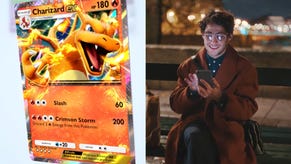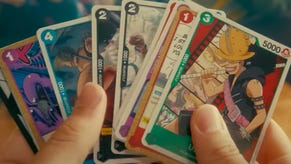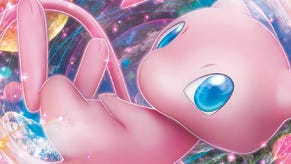SPONSORED: 10 stunning Pokémon cards that showcase the TCG’s most iconic artwork
This beautiful Pokémon card art would take pride of place in any collection.
This article is sponsored by PWCC Marketplace. Find more than 20,000 Pokémon cards for sale in PWCC's Weekly and Premier Auctions or the Fixed Price Marketplace.
The best-looking Pokémon cards go beyond their rarity or gameplay power. These are the cards that stand out solely because of their incredible art - whether that’s thanks to limited-edition artwork, an imaginative rendition of a beloved Pokémon, their iconic artist or something else.
Of course, a card’s popularity among players, fans and collectors can just be simply down to boasting some of the best artwork on any Pokémon card - but the most beautiful Pokémon cards often have a story behind their visuals that makes them more than just a pretty picture.
With thousands of cards released for the trading card game over its decades-long history - often showing off the evolving art styles of its illustrators - there’s no shortage of stunning Pokémon cards to choose from. To help you start your gallery of gorgeous Pokémon card art, we’ve picked out some of the best-looking Pokémon cards of all time, from iconic Base Set beauties and powerhouse promos to vivacious variants and radiant rarities.
1. 2000 Black Star Promo Mewtwo #12
Two icons, combined

This electrifying Pokémon card featuring iconic first-gen Pokémon Mewtwo is eye-catching for a good reason. Behind its entrancing artwork of Pokémon #150 was legendary trading card game illustrator Christopher Rush, best known as the creator of the Black Lotus - the most famous and valuable Magic: The Gathering card ever made.
Rush’s work on Black Star promo Mewtwo made the already acclaimed artist iconic for another reason; becoming the first non-Japanese illustrator to design a Pokémon card. The promo card was distributed to readers of Nintendo Power, the long-running magazine created by Pokémon maker Nintendo, in April 2000. At that time, Mewtwo had become one of the most recognisable Pokémon from the series thanks to the North American release of video games Pokémon Red, Blue and Yellow, and the release of Pokémon: The First Movie just months before.
Luckily for fans of Rush’s art, you don’t need to necessarily hunt down a copy of the 20-year-old magazine to enjoy this Mewtwo. The card’s artwork was reprinted in the 2002 Legendary Collection set, which also introduced a reverse holo variant.
Combining one of the most iconic Pokémon of all time with one of the most iconic TCG illustrators of all time in its stunning artwork, the 2000 Black Star promo Mewtwo #12 isn’t just a great-looking card - it’s a piece of TCG history.
2. 2000 Gym Challenge Blaine’s Charizard #6
Seriously hot property
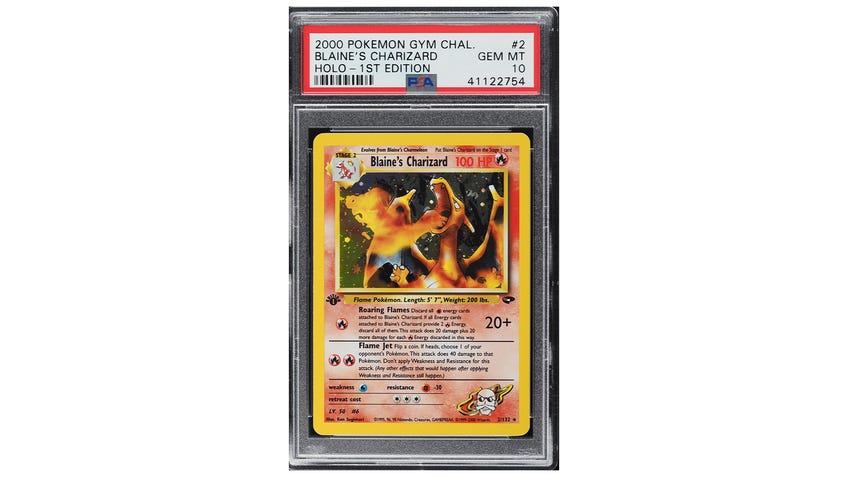
Charizard appears on perhaps the most iconic Pokémon card of all time: the Base Set Charizard, variants of which include the hugely popular “shiny Charizard” and the incredibly rare “shadowless Charizard” - the latter being one of the most expensive Pokémon cards of all time due to its fame.
The Base Set Charizard is far from the only Pokémon card featuring the fully-evolved fire-type to find a place in many a fan and collector’s heart, though.
Blaine’s Charizard was illustrated by Ken Sugimori, the legendary Pokémon art director and character designer who played a role in creating the original 151 Pokémon from the series’ first generation, as well as many of their appearances in the TCG’s earliest Base Set.
As the name suggests, Blaine’s Charizard features the Charizard belonging to Cinnabar Island gym leader Blaine, one of the most memorable characters in the Pokémon Red and Blue video games - as well as the TV cartoon based on the series. The card appeared alongside dozens of other Pokémon cards based on gym leaders’ in TCG expansion Gym Challenge, released in English in 2000.
Thanks to its starring role for the beloved Pokémon - seen roaring flames in Sugimori’s sizzling artwork - and its tie to the fan-favourite character, Blaine’s Charizard has become an icon in its own right as one of the best-looking Pokémon cards ever made.
3. 2020 Pokémon Japanese SWSH Shiny Star V Charizard VMAX #308
A supersized showcase for the legendary Pokémon

Another stunning Pokémon card starring fan-favourite fire-type Charizard, the Japanese SWSH Shiny Star V Charizard VMAX also serves as a showcase for the TCG’s VMAX cards. Introduced in the TCG’s run of Sword & Shield sets, VMAX cards sought to capture the gigantic majesty of the Dynamax and Gigantamax Pokémon seen in the Sword and Shield video games.
With such enormous Pokémon to try and squeeze onto a single card, VMAX cards see the supersized Pokémon burst beyond the traditional border of the cards, displayed in gorgeous borderless artwork.
The full-art visuals are taken to another level by VMAX cards’ alt art, which adds to the imaginative depictions of the towering Pokémon with fresh and even unique treatments for cards.
One glowing example is the Japanese Shiny Star V Charizard VMAX, which features a rainbow-colour finish and dappled texture that makes it stand out even against the likes of the TCG’s many beloved Charizard cards.
4. 2000 Neo Genesis Lugia #9
Legendary by name, legendary by nature

Introduced in Pokémon’s second generation as the cover star of Pokémon Silver - the counterpart to Pokémon Gold’s Ho-Oh - and star of Pokémon: The Movie 2000, Lugia is a psychic and flying legendary Pokémon that has gone on to become one of the most iconic Pokémon in the entire series.
Of Lugia’s many appearances in the Pokémon Trading Card Game, its very first TCG appearance on a card in 2000’s Neo Genesis expansion - the first set to include second-gen Pokémon - ranks as its most sought-after and eye-catching.
Lugia’s popularity was helped both by its appearance on booster packs for the expansion and its appearance as one of fewer than 20 holographic ‘shiny’ cards.
Adding to the Neo Genesis Lugia’s existing demand among fans was its seemingly increased rarity, caused by what is believed to be a smaller number of cards printed for Neo Genesis than sets for earlier Pokémon TCG expansions. On top of the reduced print run, the set was affected by a number of production problems that caused some of the earlier holographic cards’ gold borders to bleed on first-edition cards - making a Lugia in top-notch condition even harder to find.
In fact, fewer than 50 Neo Genesis Lugia cards have been graded in a top condition by grading specialists PSA and Beckett - making the card even rarer than the mythical shadowless Charizard. Easier to find are other Lugia cards such as the full-art card released in the card game’s 2009 SoulSilver expansion, one of the first borderless cards to show off the TCG’s artwork.
The card’s rarity means you should expect to fork out tens of thousands of dollars to pick up a perfect-condition copy on the rare occasions they appear for sale. Nevertheless, the card’s incredible rarity adds to its artwork’s lustre as one of the most recognisable and attractive Pokémon cards ever seen.
5. 2000 Japanese Neo 3 Shining Gyarados #130
The TCG’s first shiny Pokémon
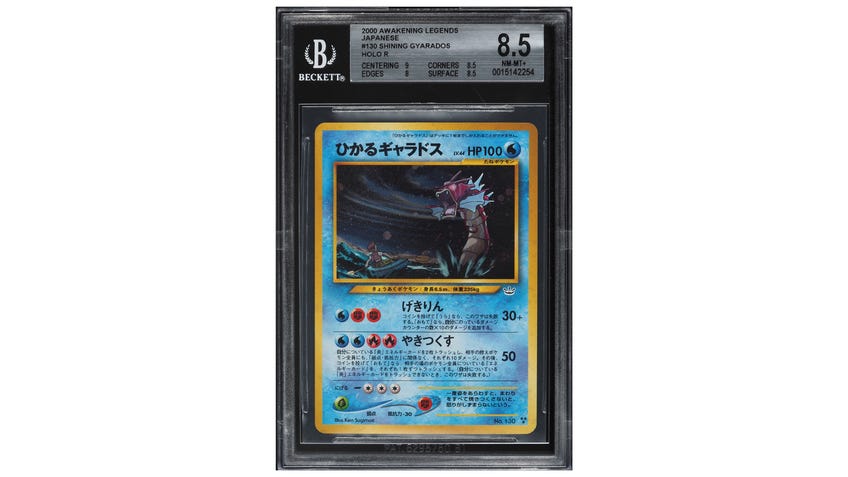
Behind perhaps only the Squirtle family of Pokémon, Gyarados is one of the most instantly recognisable water-type Pokémon of all time. Infamously evolving from the fairly innocuous Magikarp (splash!), this water dragon is a formidable aquatic foe - and its appearance on this beautiful Pokémon card captures that intimidating aura as it looms over a Pokémon trainer in a rowboat amid the raging waves.
The Shining Gyarados first burst from the depths in the Awakening Legends expansion, also known as Neo 3 for being the third in a series of Neo Series expansions released through 2000 and 2001. The set would later be released in English as the Neo Revelation expansion in late 2001.
Awakening Legends and Neo Revelation brought shiny Pokémon across to the trading card game, following their first video game appearance in Pokémon Silver and Gold. Shiny Pokémon are extremely rare variants of Pokémon with unique colouration, with only a one in more than 8,000 chance of encountering them in the video games.
Shiny Pokémon are just as rare in the card game, estimated to appear in just one in 300 booster packs - making them just as rare in cardboard as they are on screen. Alongside Shining Gyarados, the Neo 3 expansion included its pre-evolution Shining Magikarp as the first shiny Pokémon in the TCG.
The Japanese Neo 3 Shining Gyarados found in Awakening Legends pays tribute to the very first shiny Pokémon: the Red Gyarados that could appear in Pokémon Silver and Gold. With its terrific - if terrifying - artwork and extreme rarity, this fetching Pokémon card is a true treasure.
6. 2000 Pokémon Movie Ancient Mew
Good luck reading it!
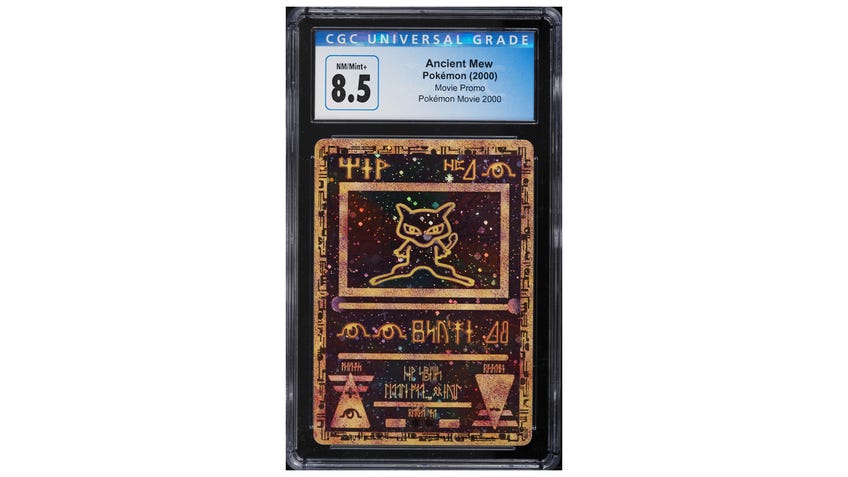
Ancient Mew is legendary among Pokémon fans of a certain age. It was the promo card you would receive if you attended a screening of Pokémon the Movie 2000 at a participating cinema, but only during the film’s first week of release in late July 2000.
Ancient Mew is a Pokémon card icon for a number of reasons. Firstly, it features the mythical Pokémon Mew, subject of many a playground rumour (“Check the truck next to the SS Anne!”) about how to catch it in video games Pokémon Red and Blue. (Spoiler: you can’t, unless you use a glitch or took part in a competition run by a Japanese magazine in 1996.) Secondly, the entire card is designed like an ancient relic with hieroglyphic-like text written in symbols, meaning you can’t use it in the game unless you translate it.
Finally, the entire card is finished in a unique holographic treatment that extends over both its front and back - making it one of very few Pokémon cards to be shiny on both sides.
Good news for anyone who never had the chance to pick one up as a kid, or lost their own copy: despite being one of the most recognisable and visually breathtaking Pokémon cards of all time, Ancient Mew is far more affordable than you might think, selling for just tens of dollars.
7. 1998 Pokémon Japanese Promo Trade Please!
A heck of a trade
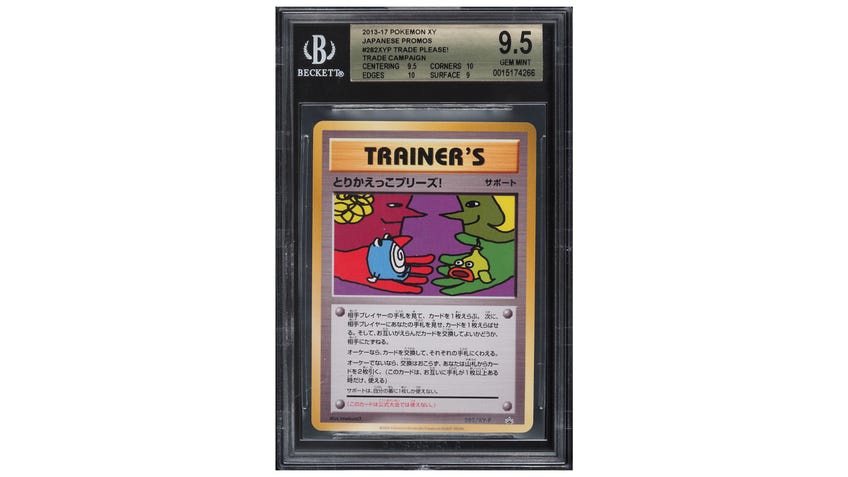
Trade Please! immediately stands out as unlike any Pokémon card you’ve seen before. Its fantastically surreal artwork is drawn by Imakuni?, a character played by eccentric musician Tomoaki Imakuni dressed in a mouse-like costume. As well as composing music for the Pokémon series, Imakuni designed a number of cards for the card game - including this promo card offered via a music album promotion in 1998.
By sending in a flyer packaged with the music album Let’s Trade Please by Suzukisan - a rap group including Imakuni - along with two Pokémon cards of their choice, fans could receive one of three cards, plus the Trade Please! card. Which cards they received was based on their choice of three “courses”: Course A offered a Charizard, while courses B and C resulted in a Blastoise or Venusaur respectively. No matter which course and card players picked, they also received a copy of Trade Please!
Like Ancient Mew, Trade Please! is one of very few Pokémon cards to also have a holographic back as well as its front. Its artwork shows two players trading a Poliwhirl and a Weepingbell
With such distinctive artwork and such limited availability - only being offered through the Trade Please promotion from February to July 1998 - Trade Please! stands out as a singular Pokémon card. Its artwork alone makes it one of the most eye-catching Pokémon promo cards of all time.
8. 1999 Masaki Promo Gengar
Ghost in the (Vending) Machine
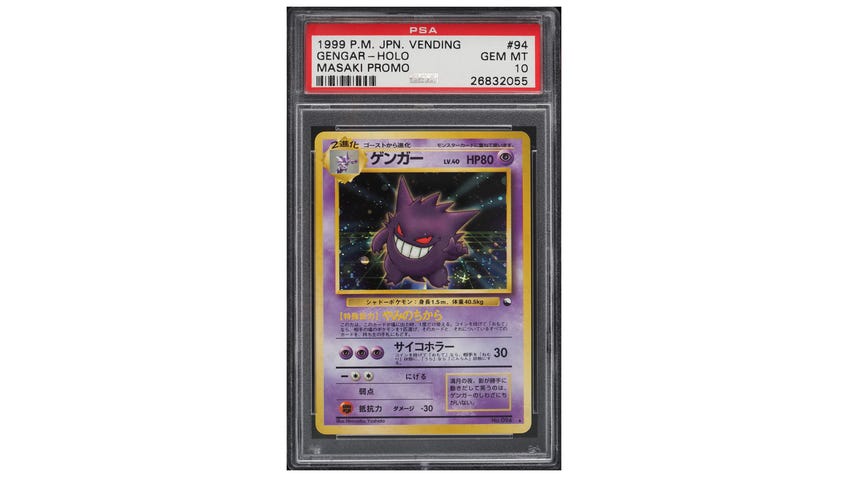
This fetching Gengar was one of five Pokémon promo cards released through a unique promotion run in Japan during the late nineties.
To grab the limited-edition cards, Pokémon fans first needed to find a copy of the Bill’s PC card (also known as Masaki's Personal Computer in Japanese). The card could only be obtained from the third series of cards released exclusively through vending machines in Japan in 1998. Participating vending machines would provide a random sheet of cards inspired by different areas in Pokémon Red and Green’s region of Kanto. Bill’s PC is inspired by the storage system in the video games that allows players to store additional captured Pokémon.
With a copy of Bill’s PC in hand, players could then send it to original Pokémon card game publisher Media Factory to participate in the Communication Evolution Campaign promotion. By including a card with Omanyte, Haunter, Graveler, Kadabra or Machoke, the player could then receive its respective evolution as an exclusive holofoil promo card: Omastar, Gengar, Golem, Alakazam or Machamp.
Of the five, the Masaki Gengar is the most sought-after and valuable - helped by its fantastic artwork that shows the popular ghost-type Pokémon against a cyberspace-like backdrop.
9. 2005 EX Deoxys Holo Rayquaza Gold Star #107
A new dimension for the popular Pokémon

Third-gen super-ancient Pokémon Rayquaza will be most familiar to fans through its star appearance on the cover artwork for Pokémon Emerald.
That - along with appearances through the Pokémon series and cameos in other video games, such as Super Smash Bros - has helped the snake-like dragon Pokémon to become one of the most popular Pokémon in the trading card game. According to PWCC, as of the start of November 2023, it was the seventh highest-selling Pokémon in terms of Pokémon cards in the previous 12 months.
Among Rayquaza’s appearance in the Pokémon TCG, its appearance in the EX Deoxys expansion is especially notable. The artwork by Masakazu Fukuda was one of the first Pokémon cards to feature a more 3D-like effect in comparison to the 2D illustrations of earlier Pokémon cards, making the EX Deoxys Holo Rayquaza stand out among its peers.
After appearing in the Japanese EX Deoxys expansion in 2004, this English-language reprint arrived the following year, featuring the same dynamic artwork of the Rayquaza curling around with its claw outstretched towards the player, even managing to break beyond the card’s artwork frame.
The action-packed artwork combines with this particular card’s extreme rarity as a holographic Gold Star card. Like other Gold Star variants, the Rayquaza card only appeared in roughly one in 72 booster packs - making it as thrilling to find as it is to look at.
10. 1998 Kangaskhan Family Event Trophy card
A family affair

Legendary Pokémon veteran Ken Sugimori lends his pen to this one-of-a-kind Pokémon card showing the mother-and-child pairing of Kangaskhan.
This particular card is particularly special when it comes to depicting the parent Pokémon, serving as a trophy card for a parent-child Pokémon card tournament held as part of the Lizardon Mega Battle in 1998. The second-ever official Pokémon TCG tournament organised, the Lizardon Mega Battle effectively served as the first big national championship for the then-fledgling card game.
In the tournaments, an adult and their younger relation formed a team who then faced off against other duos. The top eight teams were eventually rewarded with a copy of the Kangaskhan Family Event Trophy card, with the top team getting a second copy.
While the same card was later given as a prize at the Kamex Mega Battle later the same year, it wasn’t produced again, leaving the extremely limited number of cards won over 25 years ago the only copies in existence. To date, only a dozen have been graded at a perfect Gem Mint 10 by condition specialist PSA.
All of that adds to the card’s charming artwork, with Sugimori depicting the classic look of Kangaskhan with its arm raised and child in its stomach pouch against a holographic background. With artwork as delightful as the story behind its creation, the Kangaskhan Family Event Trophy card is a beautiful Pokémon card with a sweet history.






